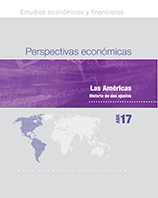Regional Economic Outlook
2 total works
Regional Economic Outlook, April 2016, Western Hemisphere Department (Spanish Edition)
by Hamid Faruqee
Published 30 April 2016
The United States has seen an improvement in economic activity, driven by consumption, and has taken a first step toward gradual normalization of interest rates. The U.S. recovery continues to support activity in Mexico, Central America, and the Caribbean, but China’s slowdown has reduced the demand for exports from South America. At the same time, the region’s commodity exporters have experienced further terms-of-trade shocks as commodity prices continue their decline globally. This report describes the policies and economic reforms needed to address the declining productive capacity in Latin America and the Caribbean. Three chapters assess corporate vulnerabilities in Latin America, analyze the degree of exchange rate pass-through in the region, and evaluate trends in public and private infrastructure investment.
Regional Economic Outlook, April 2017, Western Hemisphere Department (Spanish Edition)
by Hamid Faruqee
Published 30 August 2017
With the global economy gaining some momentum, economies of Latin America and the Caribbean are recovering from a recession at the regional level in 2016. This gradual improvement can be understood as tale of two adjustments, external and fiscal, that are ongoing in response to earlier shocks. But headwinds from commodity terms-of-trade shocks and country-specific domestic factors are fading, paving the way for real GDP to grow by about 1 percent in 2017. Regional activity is expected to pick up further momentum in 2018, but at a slower pace than previously anticipated, while medium-term growth is projected to remain modest at about 2.6 percent. The outlook is shaped by key shifts in the global economic and policy landscape—where slow growth, low productivity, and high income inequality are creating pressure for a shift toward inward- looking policies in some advanced economies. Domestic fundamentals and developments, however, will continue to play a significant role in determining growth for the region. At the same time, risks to the outlook have widened in a setting of higher global uncertainty. In this challenging external context, countries should aim for completing fiscal and external adjustments to preserve or rebuild policy buffers. Charting a course toward higher, sustainable, and more equitable growth will also require strengthening structural reforms. Specifically, closing infrastructure gaps, improving the business environment, governance, and education outcomes, and encouraging female labor participation are necessary to boost medium-term growth and foster income convergence. Chapters in this report examine the ongoing external adjustment to terms-of-trade shifts, drivers of capital flows to the region, the role of the investor base, and macroeconomic impact of migration and remittances.

